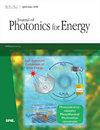Photoinstability aversion in perovskite solar cell by downconversion cadmium chalcogenide filters
IF 2.1
4区 工程技术
Q4 MATERIALS SCIENCE, MULTIDISCIPLINARY
引用次数: 0
Abstract
Abstract. Susceptibility to environmental factors, such as moisture, humidity, oxygen, heat, and ultraviolet (UV) light (photoinstability), has affected perovskite solar cell (PSC) stability in practical applications. To overcome the instability and performance degradation due to oxygen, humidity, and moisture, different strategies and encapsulation schemes have been proposed, and promising results have been obtained. However, photostability remains a major hurdle because UV light is an inherent part of the standard incident spectrum of PSCs. To prevent photoinstability and increase quantum energy harvesting levels, cadmium chalcogenide (CC) photoluminescent (PL) filters for downconverting the UV part of the incident spectra obtained for PSCs are proposed in this work. The concept was illustrated by matching 500-nm-thick CC-PL filters to the front glass of a PSC to form a CC-PL/glass/indium tin oxide (ITO)/poly(3,4-ethylenedioxythiophene):poly(styrene sulfonate)(PEDOT:PSS)/perovskite/Ag structure. Cadmium sulfide (CdS), cadmium selenide, and cadmium telluride were taken as the CC materials. Practical measurements confirmed that the PSC with the CdS-PL filter can maintain 92% of its initial value under continuous light soaking for more than 100 h. Furthermore, this PSC exhibited the best improvement in power conversion efficiency.下转换硫系镉滤光片对钙钛矿太阳能电池光不稳定性的影响
摘要对环境因素的敏感性,如水分、湿度、氧气、热量和紫外线(UV)(光稳定性),在实际应用中影响了钙钛矿太阳能电池(PSC)的稳定性。为了克服由于氧气、湿度和水分导致的不稳定性和性能下降,提出了不同的策略和封装方案,并取得了有希望的结果。然而,光稳定性仍然是一个主要障碍,因为紫外线是PSC标准入射光谱的固有部分。为了防止光稳定性并提高量子能量收集水平,本工作提出了硫族化镉(CC)光致发光(PL)滤波器,用于下变频PSC获得的入射光谱的UV部分。通过将500nm厚的CC-PL滤光片与PSC的前玻璃匹配以形成CC-PL/玻璃/铟锡氧化物(ITO)/聚(3,4-亚乙基二氧噻吩):聚(苯乙烯磺酸盐)(PEDOT:PSS)/钙钛矿/Ag结构来说明该概念。以硫化镉(CdS)、硒化镉和碲化镉为CC材料。实际测量证实,具有CdS-PL滤波器的PSC在连续光均热超过100小时的情况下可以保持其初始值的92%。此外,该PSC在功率转换效率方面表现出最好的改进。
本文章由计算机程序翻译,如有差异,请以英文原文为准。
求助全文
约1分钟内获得全文
求助全文
来源期刊

Journal of Photonics for Energy
MATERIALS SCIENCE, MULTIDISCIPLINARY-OPTICS
CiteScore
3.20
自引率
5.90%
发文量
28
审稿时长
>12 weeks
期刊介绍:
The Journal of Photonics for Energy publishes peer-reviewed papers covering fundamental and applied research areas focused on the applications of photonics for renewable energy harvesting, conversion, storage, distribution, monitoring, consumption, and efficient usage.
 求助内容:
求助内容: 应助结果提醒方式:
应助结果提醒方式:


